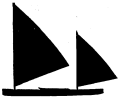
 |
CANOEING UNDER SAIL
By MAURICE D. WILT

ANOE Definition of. A canoe to be registered and to compete in any race of the American Canoe Association, must be sharp at both ends as seen from above, without counter-stern or transom. An addition to the above might be: It must be capable of being propelled by a paddle or paddles, the crew facing forward.
The canoe goes back to the dawn of history, but two or three removes from the floating log or the raft of logs. When the log was hollowed out with rude tools and fire, and the ends were sharpened, the canoe was born. Open canoes have been hollowed logs, frames with skins stretched over them, frames with tree bark put over them, and, in modern times, frames with thin planking fastened to them.
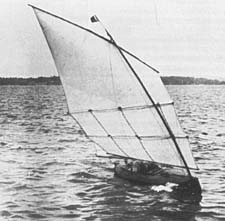
|
English Canoe "Pearl," Walter Stewart, Royal Canoe Club of London One of the challengers for the New York Canoe Club's International Cup in 1886. Series of races won by N.Y.C.C. defenders. "Pearl" carried two balance lug sails. This was the first series of races for the N.Y.C.C. Cup. |
These last are the modern Canadian open canoes, first built by Stevenson of Peterborough about 1856. As now built, the planking, about 1/4 inch thick, is fitted over moulds, smooth-skin fashion with tight joints; the numerous ribs, thin and light, are then put in, and they are fitted with outside gunwales, thwarts or crossbraces, and very short decks at each end. The modern canvas-covered canoe, the white man's improvement of the Indian birch bark, was first built some time in the early nineties in Maine. Very thin planking about 1/8 inch thick, with butted ends and edges, is bent over forms the exact shape of the canoe. The joints usually are not water-tight. Thin tapered ribs, about 1 1/2 inches wide at the middle and the same distance apart, are steam bent and clinched to the planking. Canvas is stretched over the planking, gunwales, and crossbraces, and short end decks are added, the canvas is filled and painted, and the lightest, ablest craft of its size afloat, is finished.
Open canoes, either canvas covered or all wood, have been regularly sailed for about thirty years. No models of open canoes especially designed for sailing have been developed, as the sail, for an open canoe, is essentially an auxiliary. To design for its use especially would be to spoil the boat for its main use, paddling. The best model of the open canoe, for sailing, is one with good bearings and a rather full body, about 40 square feet of sail, on a canoe 16 feet long, and 30 inches beam, is the usual rig.
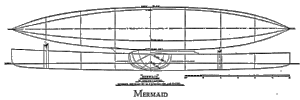
|
Sixteen-foot sailing canoe. Designed and built by W.F. Stevens and Leo Friede |
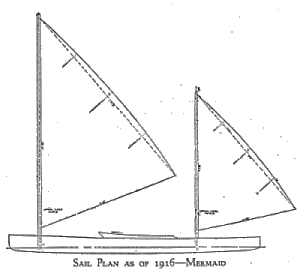
|
Sixteen-foot sailing canoe. Designed and built by W.F. Stevens and Leo Friede |
The sail is usually a lateen, in shape nearly an equilateral triangle, with a short, stiff mast, and the boom well cocked up until it is vertical and the rig becomes a leg-of-mutton, with all the sail aft of the mast. The yard and boom will each be about 9 feet long. This style of sail is probably better for windward work, the weak point of open canoe sailing.
An open canoe does her best work reaching, followed by running and windward work, in order. A single halliard and single sheet are used, and open canoes are almost always steered with a paddle. Formerly two leeboards were used, attached one at either end of a single crossbar, usually strapped or lashed to one of the cross braces of the canoe when in use. The modern practice is to use a single deep narrow leeboard, about 10 inches wide, projecting about 18 or 20 inches lower than the bottom of the keel.
The crew of one usually reclines at about the middle of the boat, with his head toward the stern, moving forward when going about, and aft when going down wind. The canoe is kept as nearly on an even keel as possible, and frequently, in a stiff breeze or in a puff, a leg is thrown over the windward side to help hold her down. A well rigged and well sailed open canoe is capable of doing from three to four miles an hour with a good breeze, over a triangular or windward and leeward course, though she can do twice that either running or reaching. This speed is no better, averaging all points of sailing, - than can be gotten out of the same open canoe under paddle. In fact, a good paddler can usually average better. All the sailing outfit of an open canoe should be easily and completely detachable so as not to interfere with her main use, paddling. In its most civilized aspect, the open canoe remains a craft best adapted to its original use, paddling, as the beast of burden of the uncivilized lake and stream countries.
Decked Canoes
The decked canoe has developed within the last sixty odd years from a small, comparatively light adaptation of the Esquimaux kayak, usually paddled but occasionally sailed, to a somewhat larger (though still small, compared to other sailing craft), but very efficient one-man sailboat. It is probably not too much to say that a modern decked sailing canoe will give a good sailor, who is also fairly young and active, more thrills than he can get in any other sailing craft afloat. The reason is not far to seek. The captain of a decked sailing canoe is also crew, helmsman, navigator, sheet tender, ballast and everything else. If he can qualify in the middle- weight class, his boat, completely rigged and equipped, will weigh no more than he himself does. She is at once the most sensitive, lively and at the same time, easily controlled sailing craft in existence.
History
John MacGregor, a Scotch scholar and sportsman, was the grandfather of the modern decked canoe. In 1865 he was adjutant of the Scottish Eight, the rifle team representing his country in the National matches at Wimbleton, England. Having been roughly handled in a railway accident, he was prevented from shooting that year. After recovering from his injuries, he decided to get afloat once more, and immediately designed the first Rob Roy canoe, which was launched two months later. He at once started on a cruise that was to cover over a thousand miles of rivers and lakes of continental Europe.
MacGregor describes this canoe as follows: "The Rob Roy canoe was built of oak, with a deck of cedar. She was fifteen feet in length, twenty-eight inches broad, nine inches deep, and weighed eighty pounds. A paddle seven feet long with a blade at each end, and a small lug sail and jib, were the means of propulsion, and a pretty Union Jack was the only ornament. My baggage for three months was in a black bag, one foot square and six inches deep. The cockpit was three feet long and eighteen inches wide, and there were two bulkheads, six feet apart." This canoe had practically no shear.
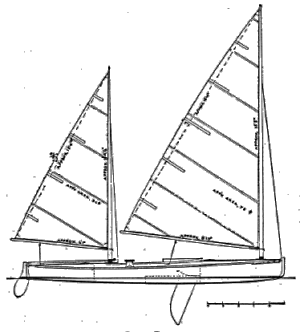
|
Sail Plan |
Sixteen-foot decked sailing canoe. Designed by Hilding Froling |
MacGregor made two long cruises after that, in other Rob Roy canoes, in essentials similar to the first one. One cruise was of nearly equal length in Sweden and Norway and across the entrance to the Baltic Sea, the Skagerrack, to Denmark. The other voyage included in its log, the Nile, the Red Sea, the Sea of Gennesareth, the Jordan, and several other rivers and lakes in the Holy Land. In all these cruises, the sails as well as the paddle were used.
This indefatigable Scot not only made these long trips - alone, mind you - but he wrote about them four fair-sized books. These were so popular that they went to five or six editions, not only in England but in America. He practically founded a new sport, and canoeing soon numbered its devotees by hundreds, and later by thousands, both in England and America.
These early decked canoes, Rob Roys, were not much as sailing craft. They were too low in the water, had too little bearings, and were altogether too wet in anything but pretty fairly smooth water. Also they were steered by paddle alone, a very ineffective method. There were soon developed boats a little wider, and somewhat deeper, with considerable shear, much better sailers, but still fairly good paddlers. They were built with fairly deep keels, carried considerable ballast and were steered by rudders.
Early American Voyages
A little later, three notable canoe voyages were undertaken by American canoemen. In 1874 Nathaniel Bishop, who was afterwards one of the original members of the American Canoe Association and its first secretary, started at Quebec a cruise that ended on the west coast of Florida. His canoe was the Maria Theresa, of the English Nautilus type, 14 feet long, 28 inches beam, depth amidships 9 inches, bow 23 inches high, stern 20 inches. This canoe was built by E. Waters & Sons of Troy, N. Y., of overlapping sheets of paper, built up to 1/8 inch thick. She weighed empty, 58 pounds, much less than the English canoes. Bishop followed the inside Sounds and Bays of the coast line from the mouth of Delaware Bay until he got to Florida, where he crossed the northern part of the state. The total length of the trip was about 2,500 miles. For the first 500 miles he had a companion, who stopped at Troy, N. Y. Bishop's book describing the trip is called The Voyage of the Paper Canoe.
The next year, Bishop made another voyage of about the same length, described by him in his book, Four Months in a Sneakbox. The boat, a Barnegat Bay sneakbox, was 12' 0" long, 4' 0" wide, and weighed 200 pounds. When not sailed, she was rowed, not paddled. This trip started at Pittsburgh, Pa., and followed the Ohio and Mississippi Rivers and the Gulf Coast eastward to the Suwannee River. As in the first voyage, Bishop travelled alone.
These long, solitary voyages southward apparently exercised a strange fascination over the early A.C.A. secretaries, for in 1881, Dr. Charles A. Neide, who succeeded Bishop in that office, started at the finish of the Lake George Meet of that year in an American Princess model canoe built by J. H. Rushton of Canton, N. Y. The Aurora, as Neide's boat was called, was 15' 0" x 31", depth amidship 9", bow 19", stern 17 1/2", cockpit 6' 0" x 21", weight (empty) 85 pounds, again a relatively lighter boat than the English cruisers. Neide, however, had a companion, S. D. Kendall, who had built his own canoe 14' 9" x 3' 0". They started north on Lake George, through part of Lake Champlain, the Champlain Canal, Mohawk River, and Erie Canal to Buffalo, thence by land to Olean, N. Y., and to the headwaters of the Allegheny River. After reaching Pittsburgh their course was the same as that of Bishop's second voyage, but ended at Pensacola, Fla. It is to be noted that Neide's canoe was quite a bit larger than Bishop's first boat; also Neide did considerably more sailing than Bishop, as his boat was much better adapted for the use of sail.
Early American Canoes
About 1868, several Englishmen, among them Messrs. W. Baden-Powell, Walter Stewart, and E. B. Tredwen, became interested in the possibility of developing better sailing qualities in the decked canoes. Baden-Powell's Nautilus No. 1 was the first model designed mainly for sailing. She had good beam, considerable shear, a well-crowned deck, and carried two sails, the larger, a standing luf, being forward. The paddle was still the means of steering. The rudder was introduced soon afterward, with lines and attached to a yoke, or to pedals in the fore part of the cockpit, the actual steering being done with the feet. The sailing was done with the crew sitting or lying on the floor-boards.
The lines of Nautilus No. 4 were brought to America by a member of the New York Canoe Club, and in 1870 the first canoes of this sailing type were built by James Everson of Williamsburg, N. Y. Several good canoes of the Nautilus or a similar type were also built by a Mr. Jarvis, an English builder of canoes and rowing boats, who came to the United States and located near Ithaca, N. Y.
Very soon after the sailing canoe was introduced into the United States, its type began to diverge from that of the English canoes. The English designs became deeper and somewhat wider, with fuller bodies and deep ballasted keels or heavy centreboards. Frequently they carried considerable inside ballast as well. Their racing rigs were often one large sail, usually a balance lug. The centreboard, if one was used, was well forward, leaving the cockpit clear, for sleeping purposes. The large board forward was frequently balinced by a smaller board aft, or by a deep dropping rudder, or by both. The cruising rig was usually a balance lug forward, considerably smaller than the racing rig, and a small dandy aft. The jib disappeared. As they were almost always sailed with the crew in a reclining position, the decks at the location of the crew's shoulders were often fitted with hinged flaps, so that the sailor could lean further to windward, when reaching or on the wind.
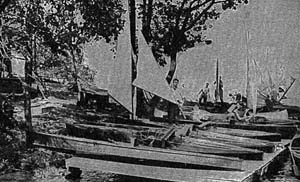
|
The Sailors' Dock at Sugar Island The American Canoe Association's headquarters in the Thousand Islands, St. Lawrence River, seven miles from Clayton, N.Y. |
Some of these features were found in the early American sailing canoes, as long as the American canoe sailors remained below deck in the English fashion. It was not very long, however, until the American sailors were sitting on the windward deck, at first during reaching and windward work only, but finally at all times. Almost immediately the necessity for the big-bodied heavy canoes, with heavy centreboards and inside ballast disappeared. The crew was his own ballast, carried in the most advantageous position, well out on the windward side. The canoe could be built lighter, with finer lines, and it was easier to handle both afloat and ashore, because of its lessened weight, and much safer in case of a capsize.
The deck position was decidedly uncomfortable, however, if there was a stiff wind blowing, causing considerable strain on the back and legs; but it was so much more effective than the reclining position that it was almost always assumed in spite of its comparative discomfort under certain conditions of wind and sailing.
In the early part of this history John MacGregor was called the grandfather of the decked canoe. The father of the modern canoe sailing was Paul Butler, who joined the American Canoe Association in 1885. His club was the Vesper Canoe Club of Lowell, Mass. His friend, H. Dudley Murphy of Lexington, Mass., himself a noted canoe sailor, pays this tribute to Butler's memory. It is quoted in part: "Few in this generation realize to what extent the sport of decked canoe sailing is indebted to Paul Butler. In the early days the canoe had no bulkheads, nor self-draining cockpit; it was unmanageable after an upset, could carry only some fifty or sixty square feet of sail, with the sailor sitting on deck, and was steered by means of rudder chains and a short fore and aft tiller. Butler, weighing only one hundred and ten pounds, invented the cross sliding deck seat, added bulkheads, self-draining cockpit, and the Norwegian tiller (a thwartship tiller with a rod to the rudder head), and invented the most wonderful hollow spars ever made. He invented the clutch cleats for the sheet lines, reefing gears, and many other appliances used with the enormous sails carried before sail-area was limited. From a craft little better or more seaworthy than our present open cruising canoe, he developed by his inventive genius the fastest sailing craft for its displacement that the world has ever seen, a seaworthy, unsinkable boat capable of a speed of fifteen miles an hour. He designed his own boats, and started W. F. Stevens, a shell builder, to building canoes that after thirty-five years are still in fine condition and among our fastest. Every man who has sailed on a sliding seat in a good breeze of wind and experienced the thrill of the speed owes a debt of gratitude for the invention and development of the finest of all water sports to the memory of Paul Butler."
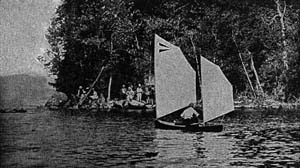
|
American Canoe, Eclipse Sailed by Reginald S. Blake, Brooklyn Canoe Club, against Walter Stewart, Royal C. C., in canoe Charm, in the second series of races for the N.Y.C.C. Cup in 1888. Series was won by Blake. Eclipse carried batswing sails. This picture taken at the A.C.A. meet at Lake George, N.Y., in 1886. |
The cross sliding seat makes it possible for the light man, by getting a little farther out on a long seat, to hold up his boat in blow, just as effectively as can a heavier man. The thwartship tiller, built a little longer for the lighter man, is just as handy to use as it is for the heavier man and the clutch cleats make it possible to release the sheets, when needed, just as quickly by a push with the toe of one's shoe as it is possible to do by hand. There were bulkheads before Butler's time. In fact, as we have seen, the original Rob Roy had them but that is a very slight error in a wonderful tribute to a wonderful man.
By 1887 Butler had begun his experiments, and in 1892 he scored his first win of the American Canoe Association Sailing Trophy, the most prized trophy open to the canoe sailor, except the International Challenge Cup.
The effect of Butler's inventions began to be felt from about 1890 on. The long deck seat, the thwartship tiller, and the tight self-draining cockpit made it possible to increase the sail-area to an enormous extent, and with entire safety. At that time and for several years after, there was practically no limit to any element of the decked sailing canoe, except the length overall and the extreme beam. The standard size, practically universal, was 16 feet overall length, and 30 inches extreme beam. On a boat of that size, two sails were carried, the total area being anywhere between 130 and in some cases 180 or 190 square feet. The writer saw a race sailed in 1894, in which the winner capsized nine times during the race and righted his boat every time, with no more inconvenience than a wetting to himself and his sails. This case, of course, was exceptional, the competition was not very keen, and he lost some time at every capsize in righting his boat, perhaps 30 or 40 seconds, but it shows of what the canoes were capable.
Like almost every unlimited class of sailing craft, these extreme canoes in a few years developed themselves out of existence. The huge batswing sails got to be so hard to hold up, in the extreme sizes, and the hulls of the boats had to be so strongly built, and consequently heavy to stand the various strains imposed upon them, that they became useless for anything but match sailing. They were too heavy for easy transportation, and they were entirely too expensive to build and maintain. Then a limit was placed on the total sail-area, first of 130 square feet, then of 110, and finally of 90 square feet - the amount allowed today to a 16' 0" X 30" canoe.
The present day sails are light, finely cut, and made, leg-of-mutton or jib-headed standing sails, laced to boom and mast. The masts are limited in length to the overall length of the canoe, and not more than two-thirds of the total sail-area may be in any one sail. The sails usually have a 3- to 4-inch roach on the leech and carry three or four light battens about 18 inches long.
A first class modern decked sailing canoe costs at the present time about $300 to $350 complete with one set of sails, spars, hollow masts, sliding deck seat, hollow thwartship tiller, cast aluminum vertically dropping centreboard, and aluminum rudder and brass fittings.
Canoe Clubs
When John MacGregor returned from his first long cruise and published the story of it in the book called One Thousand Miles in the Rob Roy Canoe, the new sport began to gain popularity at once, and the need of organization began to be apparent. The Royal Canoe Club was organized in July, 1866, and by June, 1867, the club had a membership of over 100. H. R. H. the Prince of Wales was Commodore, and John MacGregor was Captain. Its objects were stated with commendable brevity, in eight words: "To improve canoes, promote canoeing, and unite canoeists."
In the United States the growth and development of the sport was only a little behind that in England. In 1871 William L. Alden, at that time a member of the editorial staff of The New York Times, and several of his friends, all ardent canoemen, met and organized the New York Canoe Club. Several of them were newspapermen, so that the club did not lack publicity from the start. The membership grew slowly but steadily for several years. The club had no house at first, very little racing was done, and most of the activities centred on cruising. The first clubhouse was built in 1879, at St. George, Staten Island. The New York Canoe Club was the first canoe club in the United States, but others soon followed. In 188o there were eight or ten clubs in the eastern United States, by 1885 the number had more than doubled, and by 1890 it had tripled. Some lasted but a few years, others of these very early ones are in existence today, along with many new ones.
The American Canoe Association
In 1880 a call for a general convention of canoeists was issued by twenty-four leading devotees of the sport. The convention took the form of a camp at Crosbyside, Lake George, N. Y., on August 3, 4, 5, and 6. Sailing and paddling races were held each day, and the American Canoe Association was founded at a meeting in the boathouse at Crosbyside.

|
Another Picture of Leo Friede, Sailing Mermaid Picture taken at Gravesend Bay, N.Y. |
The first officers were W. L. Alden, Commodore; Nicholas Longworth, the father of the present speaker of the House of Representatives, Vice-Commodore; R. D. Wynkoop, Rear-Commodore; N. H. Bishop, Secretary; J. M. Meredith, Treasurer. The names of these officers, together with the names of ten other members, appear as the founders of the A.C.A. on a tablet erected at Crosbyside on June 16, 1911.
By 1883 the association numbered over 100 members, and by 1888 well over 1,000. Camping and racing meets of the association have been held every year since 1880. In 1887 a geographical division form of organization was perfected, and in the yearbook for 1888 appear the names of the Central, Eastern, Northern, and Atlantic Division officers and members. Two other divisions have since been added, the Western and the Delaware-Chesapeake. The Western division was the old Western Canoe Association, which had been a separate organization of canoeists of the middle western states, centered chiefly around Chicago, Cincinnati, and Milwaukee. It joined the A.C.A. in 1900. The divisions hold annual camping and racing meets and cruises, in addition to the general association meet.
The A.C.A. general meets have been held all over the north-eastern United States, but generally on the St. Lawrence River, among the Thousand Islands, and in two years farther north, in Canada.
In 1901 Sugar Island, in the St. Lawrence River, one of the Thousand Islands, about seven miles from Clayton, N. Y., was bought from the Canadian government. Sugar Island is about forty acres in area, very irregular in shape with bold, rocky shores indented by several deep bays. There are three or four small sandy beaches, and one meadow a few feet above the water level, about four acres in extent. At the edge of this meadow under the trees are pitched each year the headquarters tents and the big mess tent. A concrete dock about 500 yards from headquarters makes the landing from large motor boats or from the smaller river steamers very easy. It is an ideal spot for camping, surrounded by ideal waters for cruising or racing, either with sail or paddle.
The A.C.A. meets were held at Sugar Island annually from 1903 to 1925, inclusive, and again in 1927. The meets are always held in August; they last two weeks, and the average attendance is about 250. Members and their guests may, however, camp on the island at any time.
The 1927 yearbook contains the results of forty races and four other contests, which were held at the meet in 1926 at Turtle Island, Lake George. Of these races fifteen were for sailing canoes both open and decked, and twenty-five were for paddling canoes of different classes with crews of one, two, four, and nine paddlers. There were still more races in 1917 when the A.C.A. went back to Sugar Island.
International Sailing Races
In 1885 the New York Canoe Club offered the International Challenge Cup, a perpetual challenge trophy for sailing canoes. The cup may be challenged for not oftener than once each year by any regular organized canoe club outside of the United States. Each contest is a best two out of three affair, and each race is not less than eight nor more than ten miles.
In 1886 at the A.C.A. meet at Grindstone, Thousand Islands, Warrington Baden-Powell, with his canoe, Nautilus, and Walter Stewart, canoe Pearl, guests of the A.C.A., sailed by invitation, in the race for the A.C.A. Trophy, 7 1/2 miles. They finished eighth and ninth, respectively, in a field of fifteen. Both Baden-Powell and Stewart were members of the Royal Canoe Club and had challenged for the N. Y. C. C. Challenge Cup. The races were sailed after the A.C.A. meet, over the N. Y. C. C. course. The cup was defended by C. Bowyer Vaux, canoe Lassie, N. Y. C. C., and William Whitlock, canoe Guenn, Brooklyn C. C. The challengers were defeated. Both defenders sailed comparatively light canoes in the on-deck position, as-did also Stewart of the challenging pair. Baden-Powell sailed in the reclining below-deck position. Vaux is still a member (honorary life) of the New York C. C. and a life member of the A.C.A. These races marked the beginning of international competition in canoe sailing.
Stewart challenged again for the International Cup in 1888 with a new canoe, Charm, and was again beaten, this time by Reginald S. Blake, canoe Eclipse, of the Brooklyn C. C. Since that year, no Englishman has challenged for the cup, but there have been several races for it notwithstanding.
In 1890 Ford Jones of the Brockville (Canada) Canoe Club challenged. He and his canoe, named Canuck, had a good record in A.C.A. sailing races, but he was beaten for the International Cup by H. Lansing Quick, canoe Uno. Quick is a member of the Yonkers Canoe Club, a life member of the A.C.A. and for several years past has been president of its Board of Governors.
In 1891 Jones again challenged for the Cup with the same canoe, and was again beaten, this time by T. E. H. Barrington of the N. Y. C. C. in the canoe Toltec. Jones was persistent, and he had the right to be, for he had won the A.C.A. Sailing Trophy in 1890 and 1891, with Canuck, so he challenged again in 1892, but was again beaten by another Yonkers C. C. man, T. S. Oxholm in canoe Glenwood. Oxholm is a member of the Yonkers C. C. and of the A.C.A.
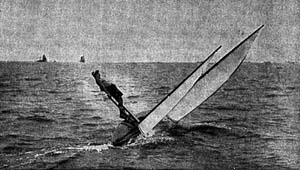
|
American Canoe, Mermaid Owned and sailed by Leo Friede, N.Y.C.C., in two series of races for the N.Y.C.C. Cup in 1913 and 1914. Both series were won by Friede. Ralph B. Britton, Gananoque C.C., Gananoque, Ontario, Canada, was the challenger in both series of races. Friede has won the American Canoe Association Sailing Trophy in this canoe eight times. Mermaid carries ninety square feet in two standing leg o'mutton sails. |
There were no more international races until 1895, when Charles E. Archibald, Royal Canadian Yacht Club of Montreal, winner of the A.C.A. Sailing Trophy in 1894, challenged with the canoe Mab. He was beaten by Paul Butler, Vesper C. C. in Wasp.
This was the last race for the International Cup until 1913, when Ralph B. Britton, another Canadian, a member of the Gananoque Canoe Club, winner of the A.C.A. Sailing Trophy in 1911, challenged with the canoe Jonah. He met the same fate as all the rest of the challengers, being beaten by Leo Friede, canoe Mermaid, a member of the New York C. C.
In 1913 Friede and Britton had sailed on pretty even terms in the A.C.A. races at Sugar Island, so Britton again challenged for the International in 1914 with a new canoe, Tomahawk, but was again beaten by Friede in Mermaid. Since 1914 there have been no races for the International Cup.
This is probably as good a place as any to note the record of Leo Friede. He has probably won more important sailing canoe races than any other man living or dead. In addition to many others, he has so far won the A.C.A. Sailing Trophy eight times, in 1914, `5, `16, `20, `22, `25, `26, and the International Cup twice. There were no Trophy races sailed in 1917 and 1918. He did not sail in 1927.
American Canoes and Their Builders
Two or three of the early American canoe builders have been mentioned early in this history. Everson's advertisement appears in several early A.C.A. yearbooks, the last one in 1892. In the 1888 yearbook appears the ad. of Charles Piepenbrink of Albany, N. Y. He built Notus, the canoe that won the A.C.A. Sailing Trophy in 1886-87, sailed by R. W. Gibson, 1886 being the first year that it was sailed for. Gibson became commodore of the A.C.A. in 1888. J. H. Rushton of Canton, N. Y., seems to have been the earliest builder of stock canoes. His advertisement appears in the American Canoeist as early as October, 1883, and perhaps before that. He must have been pretty well established even then, as he lists four different models of cruising canoes, three of them decked and rigged for sailing, and offers a 6-page catalog of canoes and pleasure boats. Rushton and his son carried on the business until about ten years ago. He built fine boats and canoes many of which are still in service. Thomas Kane and Son of Chicago, the Fulton Pleasure Boat Co. of Fulton, N. Y., the Bowdish Mfg. Company of Skaneateles, N. Y., Ontario Canoe Company, and William English Canoe Company, both of Peterborough, Ont., St. Lawrence River Skiff and Canoe Co. of Clayton, N. Y., and F. Joyner, all advertised at one time or another as canoe builders. Most of them built decked sailing canoes only to order, though some kept two or three models in stock. There was good reason for this. In the early days and to considerable extent even yet, canoeists were and are as strongly individual in their preferences as ever yachtsmen were, before the days of one-design classes. Sixteen feet by thirty inches became almost a standard size, but the designs were almost endless, hardly any two being exactly alike.
About 1886, E. H. Barney of Springfield, Mass., a man then nearing fifty years of age, designed and built Pecowsic, a light, fine lined boat, very well built. She was one of the very earliest entirely unballasted canoes, and one of the earliest if not the very first canoe to carry standing sails, that is, sails laced to light tapering masts and booms, with no halliards, topping lifts, or reefing gear. Barney had several sails of different sizes, the lower ends of all the masts being the same size, so as to fit in any of the three mast tubes. Occasionally three sails were carried, but generally only two. He won three races at the A.C.A. meet in 1886 in this canoe out of four starts. His son, George, won two in the same canoe at the 1887 meet. Pecowsic was in some respects as much of a radical departure in canoe design as was Gloriana later in yacht design.
Two or three others of the earlier builders stand out above all the rest. George W. Ruggles, a member of the Rochester (N. Y.) Canoe Club, joined the A.C.A. in 1885 and continued a member until his death about 1911. He was a man of considerable means and an excellent mechanic. He early became greatly interested in the designing and building of canoes, and for quite a number of years, in the late eighties and in the nineties, to be the possessor of a new Ruggles canoe stamped the owner at once as a good sailor. He would build for no man who was not reasonably sure to do his boat and her builder credit. Building as he did at the time when unlimited sail-area was allowed, when frequently the two huge sails were of approximately equal area, his canoes possessed marked individuality. Very narrow planking, very little shear, long straight keel with very little rocker, plumb stem and stern and very small cockpit were their outstanding features. A Ruggles canoe could be told almost at a glance. Not as light in weight as some of the earlier canoes, and with considerable trussing and bracing inside, they were very strongly built. They had to be, in order to stand the strains set up by the conflicting forces of their often huge sails on one side, and the weight of the sailor far out on his sliding seat on the other.
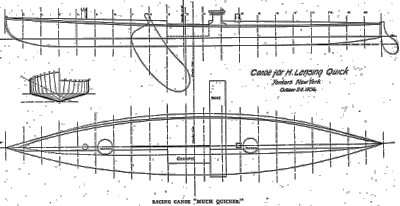
|
Drawings of a Canoe of Odd Design for H. Lansing Quick, Yonkers, |
Another very successful builder of splendid canoes was W. F. Stevens. Mr. Stevens was a waterman from his early youth. He built for himself a small sailboat when he was sixteen years old. Later he built racing shells, and rowed them too. While engaged in this business at Lowell, Mass., about 1890 he came under the notice of Paul Butler. From then on the names of Butler and Stevens became coupled among canoeists. Stevens built all the Butler designed and owned canoes, Wasp, Fly, Bee, Bug, etc., all wonders of design and workmanship and all successful racers. In 1898 he located in Bath, Maine, where he built several of his most successful canoes. In 1906 he went to Marblehead, Mass., and became associated with W. Starling Burgess, well-known naval architect and sportsman. In 1910 he retired from business and went to live at Boothbay Harbor, Maine. In 1913, however, he consented to build, from his own design, what was probably his most famous canoe, Mermaid, owned by Leo Friede and sailed by the latter in all his races. Damosel, another Stevens canoe, built about 1896, owned and sailed by James Newman, twice defeated Friede in important races on Charles River Basin, Boston, once in 1913 and again in 1919. Stevens also built Uncle Sam, in which H. Dudley Murphy unsuccessfully competed in England for the British Royal Canoe Club Challenge Cup in 1901, and he designed and built Yakaboo, a cruising canoe, in which Frederick A. Fenger cruised 8oo miles in the Caribbean Sea from Grenada to the Virgin Islands, in 1907. Yakaboo was 17 feet long, 39 inches beam, and weighed 147 pounds. She had no rudder, being steered entirely by trimming the sheets, and by shifting the centreboard forward or aft as necessary. Her rig was a small jib and two hoisting batswing sails, that could also be reefed.
The last canoe built by Stevens was Doris III, built in 1918 for Mr. Yngve Froling of Gothenburg, Sweden. Doris III is I7 feet long and 40 inches beam, an able cruising canoe. Stevens died at his farm at Boothbay Harbor in 1922 or 1923. A splendid type of down east Yankee waterman.
Another builder of several successful sailing canoes is Fred Gilbert of Brockville, Ontario. His first canoe of note was Charles Archibald's Mab, mentioned earlier.
The cost of decked sailing canoes, capable of giving a good account of themselves as racers has always been high, partly on account of the very fine light construction required, and partly owing to the fact that they were almost always what might be termed custom built. This was particularly the case after the late war. In 1922 a syndicate was formed among the members of the A.C.A. for the purpose of building a number of canoes of one design and construction, thus greatly reducing the cost. Mr. Leo Friede very kindly loaned the plans of his canoe Mermaid. The Gilbert Boat Company of Brockville, Ontario, Fred Gilbert's company, was given the contract. About twelve of these canoes have been built, and several of them have been active competitors in the sailing races during the last three years.
An interesting variation from the regular decked sailing canoe races is afforded by the Lipton Cup Races of the Western Division A.C.A. A splendid silver vase or cup, standing with its mahogany base, about 30 inches high, was donated as a perpetual challenge cup, by Sir Thomas Lipton, in 1923. It is offered for open canoes, up to 20 feet long but with the same regulations as to sail-area as the regular decked sailing canoes. Sliding seats, rudders and centreboards also are allowed. The first series of three races sailed in 1923 was won by Louis Stoerk. It is probably too early to determine their effect on canoe sailing in general, but as they stand, the Lipton Cup races seem to be a very sporty proposition.
The dimensions, 16 feet overall length and 30 inches beam, have been referred to as "standard." Probably three-fourths of the decked sailing canoes built during the last thirty-five years have conformed very closely to this combination of sizes. It is not of course arbitrary. The Sailing Racing Regulations of the American Canoe Association base both dimensions and sail limit on these sizes, but allow variations. The maximum length allowed is 18 feet, and the minimum beam is 30 inches. Beam must not be less than 5/32 of overall length nor more than 1/5. Provision is also made for minimum depth amidship, for minimum beam at waterline, and for minimum weight.
As has been stated before, sail-area is limited to 90 square feet for a canoe 16 feet by 30 inches. For each inch the beam is increased, the sail-area may be increased 3 square feet. For each inch the length is increased, the sail-area must be decreased 1/4 of a square foot.
There are good reasons for this "standard" size. A 16 foot by 30 inch canoe is about the largest that, when crated, can be shipped by rail without disproportionately large cost and inconvenience. It is nearly the largest that can be easily hauled out on a float or slip by one man, or can, when stripped of sliding seat, centreboard, etc., be carried by two men. It is nearly the smallest that can be easily and effectively sailed in fairly rough water and fairly stiff winds.
Quite a number of larger canoes have been built at one time or another, some of them very good ones, and quite fast, but they have been sailed usually by men of middle age, who probably did not care for the considerable degree of muscular activity required by the sailing of the smaller sized boats, when driven to do their best.
A decked sailing canoe is more difficult to sail well than any other type of small sailing craft. The sailor must not only have the same knowledge of the fine points of sailing required for any other boat, but in a decked sailing canoe he must do everything himself - handle sheets and tiller, and in addition be shifty in using his weight on the cross sliding deck seat, to balance a small, light, sensitive hull. The modern decked sailing canoe is, however, much easier to sail well than the old type without sliding deck seat, thwartship tiller and self-draining cockpit, because the balancing is done with much less exertion on the sliding seat than without it. Also the sailor is not bothered by the possibility of swamping if a sea is snipped. The self-draining cockpit prevents that. It is sport full of thrills for an active man who is also a good sailor.
Editor's Note. - Mr. Wilt traces his first interest in canoes and canoeing to a book that he received as a Christmas gift when he was less than twelve years of age. The book, Hudson Bay Everyday Life in the Wilds of North America, by Robert Michael Ballantyne, was published in 1879, and is the account of the author's life as an apprentice-clerk in the employ of the Hudson Bay Company for about six years beginning in 1841. About one-half the book is the story of canoe voyages on the business of the Hudson Bay Company. That Christmas gift still has a place in Mr. Wilt's library and fills a niche in his memory.
His first canoe was a homemade (and homely) craft, built when he was about seventeen years old, and his first A.C.A. meet was at Stave Island in the Thousand Islands in 1889, when a guest there for about two days.
He joined the the Red Dragon Canoe Club of Philadelphia, Pa., of which he is still a member, in 1891, and the American Canoe Association the same year. He became life member No. 64 of the A.C.A. in January, 1906, and was vice-commodore of the Atlantic Division of the A.C.A. in 1901, and several times a member of the Executive Committee. For several years past Mr. Wilt has been a member of the Sailing Committee of the A.C.A. Racing Board, and also of the Board of Governors.
During his college days he was an active oarsman, and when he turned to canoe racing, it was the paddling game that interested him; as a consequence he was an active racing paddler for over fifteen years. Cruising in a canoe with sail and paddle has been Mr. Wilt's pastime and his cruising log has averaged during twenty years between 300 and 400 miles each year except in 1917 and 1918, the years of the war.
Warington Baden-Powell in 1897 thus described the joys of canoeing:
"The real commanding charm of Canoeing over all other aquatic sports is that where there is water there is the canoe's sphere of action. It matters not whether the water be sea or a mere brook, a lake or a fish pond, canoeing can be more or less enjoyed, especially if the right type of canoe for the nature of the water is chosen. The canoe, in one form or other, may be an adjunct to yachting, to fishing and to shooting; she may be useful for travel, for exploration or even for war; but, above all, the sailing canoe on moderately open water is the finest of healthgivers, and is so at the least cost. The canoeist can at his own will sail alone or elect to sail in company; not so the yachtsman, who must have a crew, if not guests also. The canoeist can carry his hotel with him; not so the shooting or fishing sportsman, the hunting man, the cyclist or the golfer. All these are dependent on house or hotel when the sport is over, whereas living in a canoe is part of the sport of canoeing."
Knowing full well that sailors not experienced with sailing canoes would be curious to know something about their speed, I looked up data on the subject.
Record times cover races sailed at the American Canoe Association Meetings at Sugar Island in the Thousand Islands, St. Lawrence River, in the years 1922-25, inclusive, and at Turtle Island, Lake George, N. Y., in 1926. They may be taken as fairly repre- sentative of the capabilities of modern sailing canoes.
DECKED SAILING CANOES
Distance 6 miles. Course 4 times around triangle of half mile sides
or 6 times around a windward and leeward course of half mile
between mark buoys.
Average time of 30 races omitting seconds 1 hour 38 min.
Fastest time 59 min.
Slowest time 2 hours 25 min.
7 of these races were sailed in 1 hr. 3 minutes or better
___________________________________________________________________
Distance 7 1/2 miles. Course 5 times around triangle of half mile
sides.
Average time of 8 races 2 hours 25 minutes
Fastest time 1 hour 35 minutes
Slowest time 2 hours 58 minutes
___________________________________________________________________
OPEN PADDLING CANOES RIGGED FOR SAILING
Distance 3 miles. Course twice around triangle of half mile sides,
or 3 times around a windward and leeward course of half mile be-
tween mark buoys.
Average time of 20 races 1 hour 2 minutes
Fastest time 40 minutes
Slowest time 2 hours 5 minutes
Nine of these races were sailed in less than 1 hour
___________________________________________________________________
OPEN PADDLING CANOES RIGGED FOR SAILING
Distance 4 1/2 miles. Course 3 times around triangle of half mile
sides.
Average of 5 races 1 hour 20 minutes
Fastest time 1 hour 5 minutes
Slowest time 1 hour 38 minutes
___________________________________________________________________
An interesting study is that of the comparative times of the open canoes under sail and under paddle. The Record Combined race is held every year, open to both decked sailing canoes, and to open canoes rigged for sailing (called, for brevity, cruising canoes). Very few decked sailing canoes enter. The course is three miles, twice around the triangle of half mile sides. The canoes start under paddle, masts up and sails furled, and leeboards hoisted. The contestants are lined up as for a paddling race. Immediately upon passing the first mark sails are hoisted, leeboards lowered, and the second leg is sailed, to and around the second mark. The third leg is paddled and so on alternately, the finish being under sail.
Average time for 6 races 1 hour 6 minutes Fastest time 58 minutes Slowest time 1 hour 13 minutes
The Record Combined is the oldest race in the history of the American Canoe Association, having been held first in 1884, and every year since, except in 1917 and 1918, when no regularly scheduled races of any kind were held.
The contest for the A.C.A. Record is one of the hardest tests of man and canoe. It consists of three races, the Record Combined, as outlined above; the Record Sailing, 3 miles on the triangle course; and the Record Paddling, 1/2 mile. Each contestant must use the same canoe in all three races.
The record of one man, H. Dudley Murphy, of Lexington, Mass., is unique in this series of Record races. In 1891, with thirteen starters, Murphy was sixth in the Combined race, second in the Paddling race, and second in the Sailing, thus gathering the greatest number of points, and winning the Record. In 1914, twenty-three years later, Murphy again won the Record. Six men started. Murphy was first in the Combined, first in the Sailing, and fourth in the Paddling. Murphy won the A.C.A. Sailing Trophy in 1901, 1909, and 1910. Within recent years the contest for the Sailing Trophy has consisted of three races, two on the triangle, and one windward and leeward. Murphy won one of these races in the contest of 1923, and has sailed in several since that time.
Up to and including 1926 I have been able to find no record of any one man winning all three races in any one Record contest.